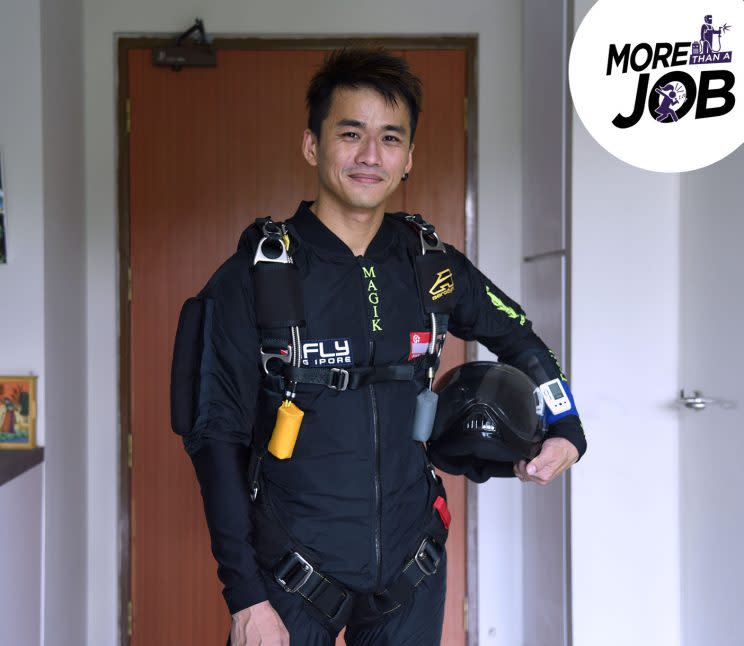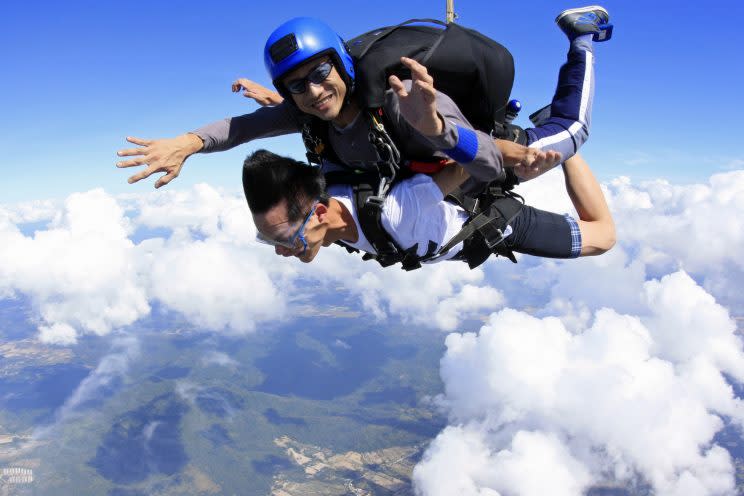More Than A Job - Jack Seet: Falling out of the sky

More Than a Job
Whatever your chosen craft, vocation or profession, we all have work to do. In this occasional series, Yahoo Singapore talks to individuals who have chosen unique and unconventional careers. For some, it’s about passion. Others have a sense of duty. But for all of them, it’s more than a job.
Around a decade after he made his first jump out of a plane, Jack Seet, 37, can still remember the moment vividly. While in Brisbane after attending a magic convention, he spotted a tandem skydiving advertisement at a bus stop and thought, ‘Why not?’
The following day, after a short ride to an airfield on the outskirts of Brisbane and a ground training session, Seet was strapped to an instructor in a Cessna 206 aircraft high above the ground. Then he took a literal leap of faith. “After the parachute opened, it was very, very peaceful. Everything is very quiet and serene. Because you don’t hear the wind, you don’t hear traffic, you don’t hear birds, you hear nothing. And it’s just quiet.”
Since then, Seet has clocked more than 800 jumps. Certified as an instructor in 2013, he is one of only three private skydiving instructors in Singapore. Seet sounded like a character from the cult movie “Point Break”, about a group of surfing/skydiving bank robbers, as he told Yahoo Singapore about the appeal of skydiving. Each jump only lasts some 45 to 60 seconds, but going by Seet’s description, it is almost a transformative experience.
“It is kind of like meditation. The minute you exit the plane, nothing else exists except for that moment. You are in the present, you are not thinking about, what am I going to have for dinner?”
“During the jump, everything else disappears and you become hyper-aware. So when you are in that zone, there is no fear. There is only the here and now.”
Seet, who has a degree in psychology, is not your typical 9-5 office worker. Besides being a skydiving instructor, the father of one is also a magician and sings and plays guitar in a band. He said with a laugh, “I like to think of myself as an odd job labourer. I like to bring experiences to people.”
Together with his colleagues at Skydive Singapore, Seet typically trains 15 to 20 Singaporean students in a year, bringing them to a drop zone near Pattaya, Thailand for jumps. Skydive Singapore’s students also hail from countries such as India, Japan, Hong Kong and China. Further, it conducts courses for experienced skydivers who aspire to be coaches, and instructors. Commercial skydiving in Singapore is not allowed due to airspace restrictions.
The students are typically in their 20s and 30s, while Seet’s oldest student was 60. Some are casual customers who just want to do a tandem jump ($450). Others are on the Accelerated Free Fall (AFF) course ($4,500), certified by the US Parachute Association (USPA), which takes in nine jumps and certifies you to jump solo. Some are gunning for a license – a minimum of 25 jumps – which clears you to jump with other jumpers. Each jump costs $40 while a second-hand parachute can set you back $6000-$7,000, if your goal is to jump regularly.
Understandably, the prospect of jumping out of a plane in mid-air at 4,000 metres above ground level can elicit some extreme reactions. “I have met people who have thrown up, in free fall or under canopy. I have seen people cry before they get out of the plane,” said Seet. Others want to use their selfie sticks during the jump, which is a strict no-no for a very good reason: if it gets entangled with any part of the parachute, as Seet puts it, “it’s not going to be fun”.

Interestingly enough, none of his students has backed out of a jump once they are on the plane. Perhaps it is down to the fact that there is nowhere to hide on a seven-seater Pilatus Porter PC-6, and nowhere else to go.
“Most people, once they get into the plane, they realise that their fate is pretty much sealed already,” said Seet with a laugh. “(But) we do have a rule: if you’re feeling really uncomfortable with it, no one can force you to jump.”
Seet did not set out to become an instructor but eventually became one partly out of the need to “feed this addiction”. After all, a tandem skydiving instructor requires at least 500 jumps, while AFF instructors must clock at least six hours of free fall.
It might seem like a lot of effort to go to for a very short – and expensive – thrill. After all, the longest Seet has ever spent in the air is about two minutes, during a wing suit jump. This involves gliding through the air using a wingsuit before eventually deploying a parachute.
But for Seet, it is a feeling that you cannot get anywhere else. “For me, it is a form of freedom because in no other sport are you so completely free in terms of movement. Ultimately, the minute the parachute opens, you’re on your own. That silence and peace is something that you don’t really get anywhere else.”
Related stories:



